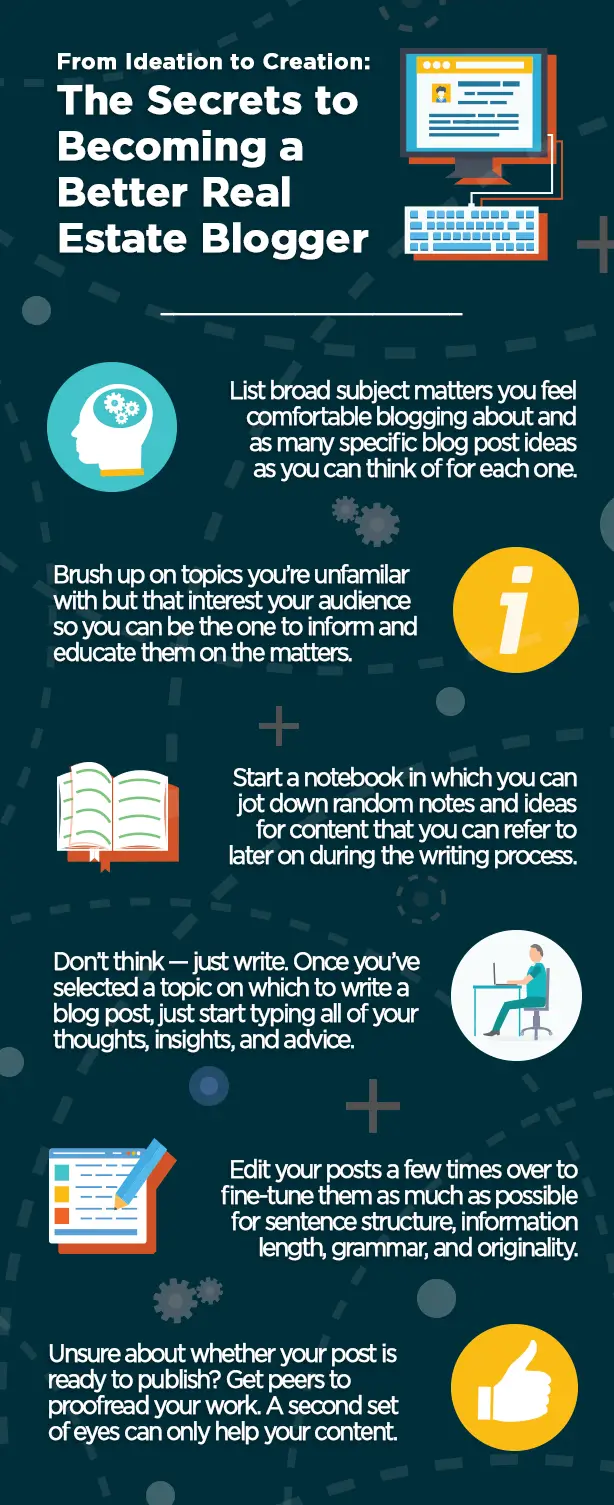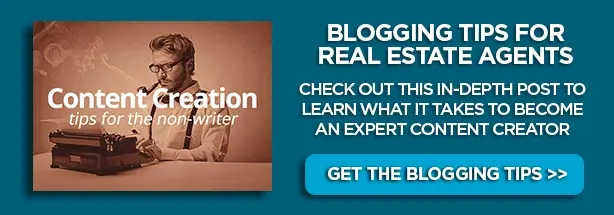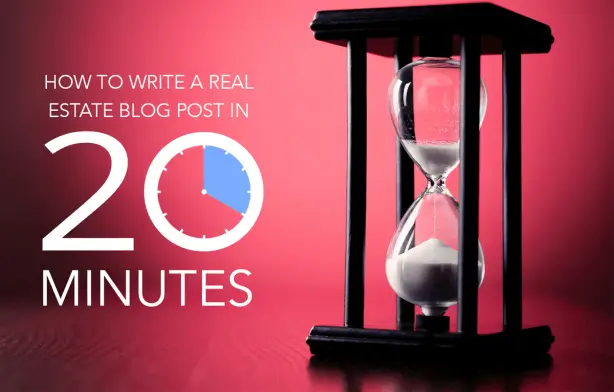It’s important to know how to write a good real estate blog post — one that your audience finds informative and valuable and gets them to come back to your site frequently. The perceived problem for real estate agents lies in the fact that many think it takes hours and hours to produce blog content. But that’s just not the case. In fact, the opposite can be true: You can write an in-depth, interesting, and illuminating blog post before finishing your first cup of coffee in the morning. You just need to know the steps to take for planning, producing, and publishing a good post.
Planning Out Your Real Estate Blog: Ongoing
Before you can successfully churn out your blog posts, you need to have a real estate blogging strategy in place. Brainstorming topics and article ideas, adding them to an editorial calendar, and developing a specific publication schedule all should be taken care of before diving in to your real estate agent blog. In the long run, setting time aside once every few weeks to generate ideas for your blog and narrow those topics down to subjects for posts will lead to more thoughtful articles that keep your audience coming back to learn more.
Brainstorm topics, news, and events you want to cover.
As you can see from checking out thriving real estate agent blogs, the agents behind them don’t just write articles on a single subject — they hit on multiple content areas routinely.
For starters, there’s the basic “evergreen” posts, which aren’t time-sensitive and provide general information on a topic. Then, there are newsjacked real estate blog posts, which take into account important and recent news stories that affect your audience, like mortgage regulations coming down from the local, state, or federal government, and new commercial developments that could lead to more jobs nearby.
There are also how-to blog posts (e.g. “How First-Time Buyers Should Shop for a Home Loan”), listicles (e.g. “The Top-12 Daycare Centers in [Market Name Here]”), and curated posts (e.g. “20 Resources to Make Your Move a Cinch”), among other popular article types, of which you can easily take advantage.
Sit down for an hour once a month and select the topics you feel ready to write about. From there, you won’t have to worry about ideas for several weeks, leaving you time to focus on your other marketing and sales activities.
Create your blog’s editorial calendar and organize your post ideas.
Randomly writing and publishing your real estate blog content may be an effective strategy in the short term. But if you’re not tracking the types of articles you produce and topics you cover, along with the frequency you publish those posts on your website, you won’t provide the greatest value to your audience.
Here’s another way to put it: How-to articles can greatly inform your audience, but if you solely produce a dozen of these posts in a row with roughly the same structure and format, your content will become stale fairly quickly, which could lead to a drop-off in traffic and lead generation from your blog. The cure is simple: Establish a real estate blog editorial calendar that records every piece of content you create. The benefits of using this kind of calendar are:
- It prevents content chaos: You might have an excellent memory, but you’re bound to become overwhelmed after a few months of blogging if your main tracking method is your brain. The easier route to take is to create a spreadsheet that organizes your ideas and completed posts in an orderly fashion.
- It provides inspiration: Coming up with one new blog post idea after another seems simple in theory. After the first few dozen articles you publish, though, chances are your idea well will run dry. Write out all of the content you’ve created in a calendar so you can easily invent spin-off ideas from past content.
- It allows for post measurement: While you should mainly rely on your Google Analytics account to teach you about your content’s success, you can export those data points to your editorial calendar so you can see your best- and worst-performing blog posts and figure out how to improve future articles.
A living, breathing document that takes away the hassle of having to recall every facet of your blog content — that’s the true value in using an editorial calendar, so flesh one out on your own (or download an existing template online, of which there are many) to keep close tabs on your articles.

Set your real estate blogging schedule at least a month in advance.
Time is sparse for agents, so instead of wasting it, schedule the next several blog posts for the weeks ahead and get it over with all at once. A single scheduling session in which you arrange your posts for publication can remove the burden of having to allocate too many hours combing over which articles to publish in the near term.
Think of it this way: You will have complete freedom from your blogging responsibilities (save for checking in on the performance of your posts in your Google Analytics account) throughout the overwhelming majority of each month and, instead, only have to spend a few hours of one day to keep your blog strategy moving in the right direction.

Writing Your Real Estate Blog Post: 10 Minutes
With a plan in place, it’s time to turn your attention to content creation. Writing a blog post requires concentration, so find a quiet place in your home, office, or a local cafe, close out all your internet tabs and you’re set to start typing away. It really is as simple as sitting down at your computer, cracking your knuckles, and getting to work.
As Copyblogger Founder and CEO Brian Clark once said, “Don’t focus on having a great blog. Focus on producing a blog that’s great for your readers.” In other words, don’t try to appease everyone with your blog content. Rather, solely consider the wants and needs of your audience and whether they would find your blog posts convenient, informative, and enlightening.
Select the next post idea in your editorial calendar and start writing.
While it’s helpful to have a plan for how to structure each post and what voice to use, your first priority is just to get your thoughts out of your head and onto the screen. The editing process is the ideal time to worry about how you come across and if you covered every detail in your content. For now, just let the ideas flow and get every thought, perspective, and opinion onto the screen.
Complete sentences are preferred during this period, but if you feel more comfortable adding shorthand for the time being, by all means. Just make sure you can understand what you intended to say regarding each point later on (forgetting the meaning behind scribbles and jumbled notes is a headache many writers face).
Writer’s block is an inevitable eventuality, as it is with every other blogger on the planet, so if the inspiration isn’t there, relax: It’ll come back — it always does. Consider successful blogger Jeff Goins’ tips regarding how to overcome writer’s block, including his not-so-obvious (but effective) point of just writing anyway, even if you don’t love exactly what you write.
Check out our article about: Automated blog content.
Scan your final product to determine the best headline to use.
You’ve finished writing the meat of the post: The introduction sets up the subject, the body explains the topic in detail, and the conclusion lays out your final thoughts on the matter. While there are still some adjustments to make to the article before it goes live, 90% of your blog post is done, meaning you only have to worry about one more piece of copy — the headline.
The most captivating content headlines are the ones that accomplish a combination of piquing interest, teasing an interesting subject, and explaining the exact topic discussed. One thing any quality blog post title must have, though, is a clear value proposition.
People have tons of content at their disposal, so they need to know off the bat whether an article will teach them something new or inform them further on a subject they already know well. Create great blog headlines that get across the main gist of your posts and use enticing language.

Editing Your Real Estate Blog Post: 5 Minutes
Inspecting one’s own writing isn’t the most enjoyable task, whether you’re a novice working on a blog or a veteran working on your 10th novel. Regardless of your sentiment toward proofreading your own work, it’s a must-do activity once you’re done writing.
Organize your thoughts and points in a cohesive order.
The initial step to take in the editing process is to rearrange the sentences, paragraphs, and sections on the screen into an order that reads well and looks aesthetically pleasing.
Blogging expert Ramsay Taplin, who helps writers monetize their blogging efforts, notes the look and feel of your posts are just as important as the content in each one. Areas you need to pay close attention to include the article’s flow (Is it easy to transition from one sentence to the next?), attractiveness (Do the font, font color, and font size make your posts look appealing?), and format (Do you implement a consistent, easy-to-scan article structure?).
Take all of these points into account regarding your real estate blog posts’ final version. Deficiencies in these core components can lead visitors to abandon your page (or site altogether) and look for content elsewhere.
Pay close attention to your introduction and conclusion.
Of all aspects of your blog posts, the intro and conclusion are arguably the most important to nail. Why? Because if you don’t hook the readers from the start and leave them with closing thoughts that help them understand what they’ve just read, they won’t see benefit from your content.
You need to persuade visitors with your intro to stick around to read the entire post with an enticing beginning and conclude your content by explaining what next steps readers should take — explain what the article means to them.
For example, if you close a news piece about an employment increase in your market, say something that indicates your audience should keep an eye on the topic (e.g. “With jobs booming, home values may go up as well, meaning it could become a prime time to sell soon.”)
Ensure your work is comprehensible, comprehensive, and captivating.
The final editing task involves rereading your work several times over to make sure every point you wanted covered was covered, turns of phrase and metaphors fit in appropriately, and the advice you gave is sound and clear. Additionally, examine your post from top to bottom to determine if the information would make you want to check out your blog again.
It’s difficult to put yourself in your audience’s shoes and read your content from a fresh perspective, but do your best to scrutinize your own work. Doing so will only help you tighten up the language, make your focus clearer, and alter content as needed.
Publishing to Your Real Estate Blog: 5 Minutes
The finish line is near. Once your post has been produced, you can copy and paste it into the content management system (CMS) for your real estate website. Regardless of the software you use, creating a draft of your post, optimizing it, and eventually publishing it to your site should take mere minutes.
Optimize your blog post for SEO by adding in relevant, long-tail keywords.
Without adjusting your post for SEO, you likely won’t see much traffic from search engines, so take time to carefully research and select terms and phrases associated with your local market. Of the many real estate blogging tips listed here, optimizing your content for search is one of the most important tasks to undertake. Sure, you can share your articles across social media and send emails to leads, but search engines are one of the best means for your audience to discover you.
Choose videos, photos, and links to accompany the copy.
From linking to other relevant content online (e.g. news articles, blog posts, reports, ebooks, etc.) to including multimedia that elaborates or confirms your points, your posts need background information, photos and videos related to their topics.
Any videos you include should correlate closely with your posts’ themes. Links to external sources also need to be carefully selected. Only reputable publications, blogs, and resources should be cited — and linked within your posts to phrases that accurately describe the content being linked. Linking to disreputable sources, like sites that solely post and share shady content and conduct black hat SEO practices, will only harm own SEO efforts.
Review your copy one last time, make adjustments, and publish.
Congratulations — you’re almost there! All that’s left is to take a quick glance at your post to make sure the aforementioned details are handled. Once the article is clean and ready to go, click publish and start the real estate blog post promotional process — another activity that, over time, will become more and more natural to you.
Still need help learning how to write a blog entry? Check out the Placester Academy article below, which details specific tips and tricks that can help you start creating real estate content marketing material for your audience.

How do you plan out your real estate website content for your blog? What’s your method for producing posts quickly and efficiently? Share your blogging techniques with us below!
<popup-trigger-campaign15><popup-trigger-campaign15>





